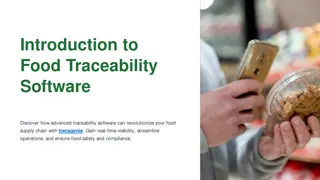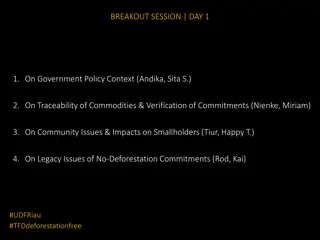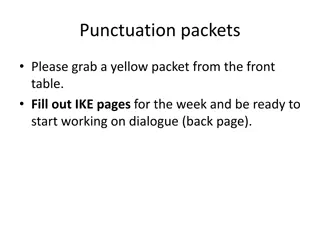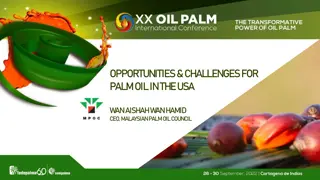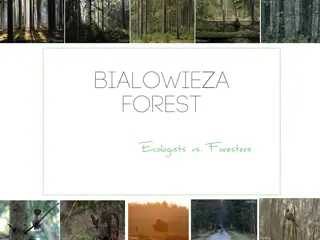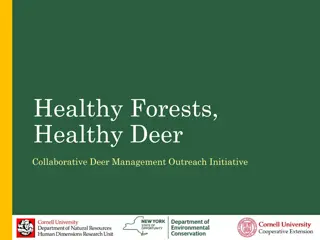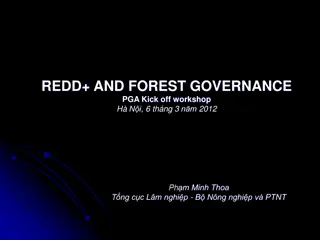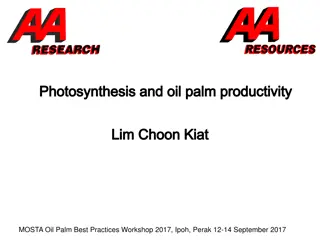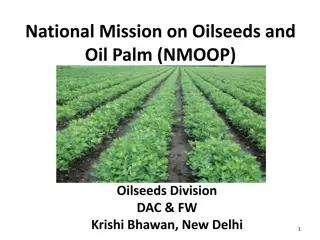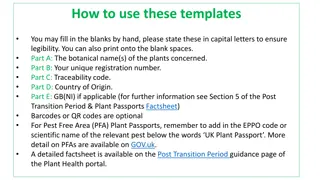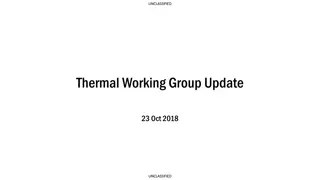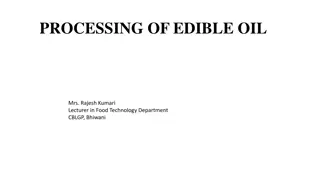Palm Oil Traceability Working Group (TWG) Presentation to Tropical Forest Dialogue Workshop May 2015
The presentation outlines the rationale and purpose of the TWG, emphasizing the need for a common definition of traceability to avoid confusion and inefficiencies. It highlights the progress made to date, including defining traceability criteria and commissioning Accenture for solutions. The TWG aims for full traceability of palm sources by 2020 and discusses leveraging existing initiatives like RSPO. Accenture's study recommends an industry-wide traceability platform to address key challenges and enhance competitiveness, with KnownSources identified as a potential developer.
Download Presentation

Please find below an Image/Link to download the presentation.
The content on the website is provided AS IS for your information and personal use only. It may not be sold, licensed, or shared on other websites without obtaining consent from the author. Download presentation by click this link. If you encounter any issues during the download, it is possible that the publisher has removed the file from their server.
E N D
Presentation Transcript
Palm Oil Traceability Working Group (TWG) Presentation to Tropical Forest Dialogue workshop May 2015
Rationale and purpose of the TWG Many companies announced commitments to traceability, but definitions vary Concern that multiple traceability definitions create confusion and proliferation of requirements and systems, leading to inefficiencies and extra costs IDH convened small yet significant group of growers, traders and users to develop a common definition of traceability and how to leverage traceability for sustainability Any outcomes must support and align with existing initiatives (e.g. RSPO), rather than creating something new
Members of TWG Regular attendees Have attended/ expressed interest
Progress to date Alignment on traceability definition and glide path Commissioned Accenture to recommend pragmatic solutions to key challenges and assess traceability systems Developing risk assessment tool and mechanisms for verification RSPO interested to trace non-certified oil and platform integration Co-funding development of traceability platform
Definition and glide path Traceability is defined as knowing all palm sources within one's supply chain all the way to plantation level (including smallholders), and traceability to mill is an intermediary step in achieving full traceability. Traceability is not a chain of custody concept and is not the same as segregated. Traceability is not the end goal but a critical step for sustainability Key criteria (for mill level traceability) are: mill name; mill location (coordinates); mill parent company; certification/verification status; % traceable (from refinery to mill initially, later from mill to plantation) Aligned on the following glide path to traceability: All mill and plantation sources known and certified/ verified 2020* All mill and plantation sources known All mill sources known 2015* *Year end. Timeline is indicative only. Each company has its own commitments and targets, but most are aligned around these dates.
Accenture study Accenture commissioned to recommend pragmatic solutions to key challenges and assess traceability systems Key challenges include suppliers fear of being bypassed and additional time and effort required without clear payback Recommendation: industry wide traceability reporting platform (blackbox) to overcome competitiveness and cost concerns Platform should be interoperable with RSPO E-Trace and companies existing traceability systems, and cover non-certified oil Based on assessment of six vendors, KnownSources emerged as best positioned to develop such a platform for palm oil KnownSources is not a tracking system like E-Trace, but a platform for mapping suppliers and reporting their traceability and other criteria in an industry-standardized way
Risk/priority assessment methodology for verification WRI co-leading development of a methodology through which companies can view their supply base and prioritize mills for action where necessary based on environmental and social criteria Mills indicated as high-priority would be subject to on-the-ground verification to confirm risks and further investigate additional potential issues (e.g. social risks) Where issues are identified, companies would seek to support change in practices to improve performance against the risks If no progress is observed over a specified time, companies could consider exclusion as a last resort For lower priority mills, companies might rely more heavily on existing certification mechanisms or standards rather than prioritizing verification
Schematic of assessment and verification process Grace period Exclude Improve practices Traceability to the mill level established Verification on the ground* Record of verification maintained by mill owner and buyer(s) Annual mill assessment (desktop + remote sensing) Consolidated mill dataset developed Possible verification, certification, etc. on case-by-case basis. Record of assessment incorporated into WRI system and/or traceability platform? *TWG currently exploring how this could be done Illustrative only
Potential for integration with RSPO TWG is proposed as RSPO Innovations Lab supply chain initiative Coordination on FFB Legality and Traceability Task Force RSPO agreed to manage traceability of all oil (certified and noncertified) in order to provide a single, efficient system Known Sources platform could be endorsed and/or administrated by the RSPO Certified oil enters GREEN LINE to be traced as certified throughout the supply chain End user can trace oil regardless of certification Mill reports data on all oil to RSPO Non-certified oil enters RED LINE to be traced as non certified throughout the supply chain Illustrative only
Way forward and next steps Coordinate with other initiatives (KADIN-IPOP, RSPO FFB Task Force, SHARP, Consumer Goods Forum) Continue to engage with RSPO and its members Operationalise traceability platform and integration with new RSPO system Refine risk assessment and verification tools; consult more widely with stakeholders, e.g. NGOs Begin projects on the ground in Indonesia and Malaysia
Example of proposed platform Single platform Common reporting platform 5 key criteria (see previous slide) would fed from individual systems and be housed here* This data would be audited/verified by an independent 3rd party periodically Multiple Systems Company A traceability system Company D traceability system Company B traceability system Company C traceability system *Alternatively, volume data could be held mainly by individual systems, requiring only % traceable passed to platform. That could make data validation and verification more complex.
Illustrative platform interface appearance (buyer view) USER: Buyer A My suppliers Owner % traceable Refiner x +Click + to view mills & suppliers Refinery 1 90% Refiner y +Click + to view mills & suppliers Refinery 2 90% Refiner z -Click - to hide mills & suppliers Refinery 3 80% Mill name Geo coordinates Parent company Certification status Risk status % traceable* Mill a X: 000000 Y: 000000 Refiner z RSPO Low Mill b X: 000000 Y: 000000 Independent company n none High. To be verified 11/2014. Click here to view risk assessment Appearance and content illustrative only. *for the future. Not immediately required
Concession analysis: Indicators and thresholds Category of Risk RSPO Certified Adherence to Legislation (Indonesia) Adherence to Legislation. (Protected areas; outside Indonesia) Deforestation All tree cover loss How calculated Is the mill listed by RSPO? Concessions overlap with illegal land (APL/HPK)? Low Risk Certified Medium Risk n/a High Risk Not Certified 0% n/a >0% Concessions overlap with protected areas 0% n/a >0% A combination of the following: % of total tree cover that was lost in concession areas (2000-2012) <5% 5% - 28% >28% Tree cover loss on primary forest / intact forest landsc. % of primary forest lost within concession areas (2000-2012) 0% n/a >0% Recent clearance alerts # of clearance alerts in concessions (Jan 2013 current month) TBD TBD TBD Recent clearance alerts on primary forest # of clearance alerts on primary forest in concession areas (Jan 2013 current month) 0 alerts n/a >0 alerts Carbon/HCS (when ready) Peat Loss on Peat % of carbon-rich land lost within concession 0% n/a >0% % of tree cover loss on peat lands 0% n/a >0% Presence of Peat % of concession area that is peat land 0% 0-20% >20% Fires Count of fire alerts over XXXX period 0 n/a >0
Radius analysis: Indicators and thresholds Category of Risk RSPO Certified Adherence to Legislation (Indonesia) Adherence to Legislation. (Protected areas; outside Indonesia) Deforestation All tree cover loss How calculated Is the mill listed by RSPO? Low Risk Certified Medium Risk n/a High Risk Not Certified % of radius with illegal land (APL/HPK)? TBD TBD TBD % of radius with protected areas TBD TBD TBD A combination of the following: % of total tree cover that was lost in radius area (2000-2012) TBD TBD TBD Tree cover loss on primary forest / intact forest landsc. % of primary forest lost within radius area (2000-2012) TBD TBD TBD Recent clearance alerts # of clearance alerts in radius (Jan 2013 current month) TBD TBD TBD Recent clearance alerts on primary forest # of clearance alerts on primary forest in radius area (Jan 2013 current month) TBD TBD TBD Carbon/HCS (when ready) Peat Loss on Peat % of carbon-rich land lost within radius TBD TBD TBD % of tree cover loss on peat lands TBD TBD TBD Presence of Peat % of radius area that is peat land TBD TBD TBD Fires Count of fire alerts over XXXX period TBD TBD TBD
How to approach supply sheds Political will TWG member priority areas* High deforestation/ carbon risk Where the magic happens Need for effective carrots and sticks for 3rd party suppliers engagement IDH willing to co-fund and innovate solutions for these Examples could be: productivity improvements, public recognition, more attractive financing, greater efficiency, etc. *may be linked to volumes, business relationships etc.




